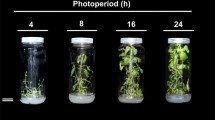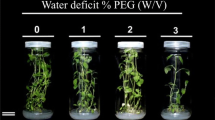Abstract
Three major cultivated Mentha spp. (M. arvensis, M. citrata and M. cardiaca) were grown under short-days, normal-days or long-days for 60 cycles. Subsequent to photoperiodic treatment, the plants were assessed for growth behaviour, essential oil content, oil composition and essential oil biosynthesis. The species grew better under long-day conditions. The long-day treatment resulted in flowering in M. citrata, which normally does not flower under our conditions. The oil concentration and biogenesis was maximal in short-day plants. The photoperiodic treatment also affected the oil composition. The observations are discussed in relation to physiology of the oil biogenesis.
Similar content being viewed by others
References
Ascensao L and Pais MSS (1987) Glandular trichomes of Airtimes campestral: ontogeny and histochemistry of the secretory product. Bot Gaz 148: 221–227
Burbott AJ and Loomis WD (1967) Evidence for metabolic turnover of monoterpenes in peppermint. Plant Physiol 44: 173–179
Chappell J (1995) Biochemistry and molecular biology of the isoprenoid biosynthetic pathway in plants. Ann Rev Plant Physiol Mol Biol 46: 521–547
Clark RJ and Menary RC (1979) Effect of photoperiod on the yield and composition of peppermint oil. J American Soc Hort Sci 104: 699–702
Clark RJ and Menary RC (1980) Environmental effects on peppermint (Mentha piperita) Effect of day length, photon flux density, night and day temperature on yield and composition of peppermint oil. Aust J Plant Physiol 7: 685–692
Croteau R, Karp F, Wagaschal KC, Satterwhite DM, Hyatt DC and Scotland CB (1991) Biochemical characteristics of a spearmint mutant that resembles peppermint in monoterpenoids. Plant Physiol 96: 589–593
Duriyaprapan S, Britten DJ and Basford KE (1986) The effect of temperature on growth oil yield and oil quality of Japanese mint. Ann Bot 58: 729–736
El-keltawi NE and Croteau R (1987) Salinity depression of growth and essential oil formation in spearmint and majoram and its reversal by foliar applied cytokinin. Phtochemistry 26: 1333–1334
Ezekiel R and Bhargava SC (1993) The influence of photoperiod on the growth and development of potato (Solanum tuberosum L.) - A review. Plant Physiol Biochem 20: 63–72
Grahle A and Hoeltzel C (1963) Photoperiodic abhangisket der beldung des atherischen ok bei Mentha piperita L. Naturwisessenschaften 50: 552
Guenther E (1955) The Essential Oils, vol. 1. New York: Van Nostrand, pp 316–319
Lichtenthaler HK, Rohmer M and Schwender J (1997) Two independent biochemical pathways for isopentenyl diphosphate and isoprenoid biosynthesis in higher plants. Physiol Plant 101: 643–652
Longston RG and Leopold AC (1954) Photoperiodic responses of peppermint. J Amer Soc Hort Sci 63: 347–352
McCaskill D, Gersheuzon J and Croteau R (1992) Morphology and monoterpene biosynthetic capabilities of secretory cell clusters isolated from glandular trichomes of peppermint (Mentha piperita L). Planta 187: 445–454
McGarvey DJ and Croteau R (1995) Terpenoid metabolism. Plant Cell 1: 1015–1026
Radford PJ (1967) Growth analysis formulae-their use and abuse. Crop Sci 7: 171–175
Ramos-Valdivia A, van der Heijden R and Verpoorte R (1997) Isopentenyl diphosphate isomerase: a core enzyme in isoprenoid biosynthesis - A review of its biochemistry and function. Nat Prod Rep 14: 591–603
Sangwan NS, Farooqi AHA and Sangwan RS (1994) Effect of drought stress on growth and essential oil metabolism in lemongrasses. New Phytol 128: 173–179
Sangwan RS, Farooqi AHA, Bansal RP and Sangwan NS (1993) Interspecific variation in physiological and metabolic responses of five species of Cymbopogon to water stress. J Plant Physiol 152: 618–622
Shanker S, Ajaya Kumar PV, Sangwan NS, Kumar S and Sangwan RS (1999) Essential oil gland number and ultrastructure during M. arvensis L. leaf ontogeny. Biol Plant (In Press)
Singh N, Luthra R and Sangwan RS (1991) Mobilization of starch and essential oil biogenesis during leaf ontogeny of lemongrass (Cymbopogon flexuosus). Plant Cell Physiol 32: 803–811
Voirin B, Brun N and Bayet C (1990) Effect of day length on the monoterpene composition of leaves of Mentha × piperita. Phytochemistry 29: 749–755
Author information
Authors and Affiliations
Rights and permissions
About this article
Cite this article
Farooqi, A., Samgwan, N. & Sangwan, R. Effect of different photoperiodic regimes on growth, flowering and essential oil in Mentha species. Plant Growth Regulation 29, 181–187 (1999). https://doi.org/10.1023/A:1006248019007
Issue Date:
DOI: https://doi.org/10.1023/A:1006248019007




